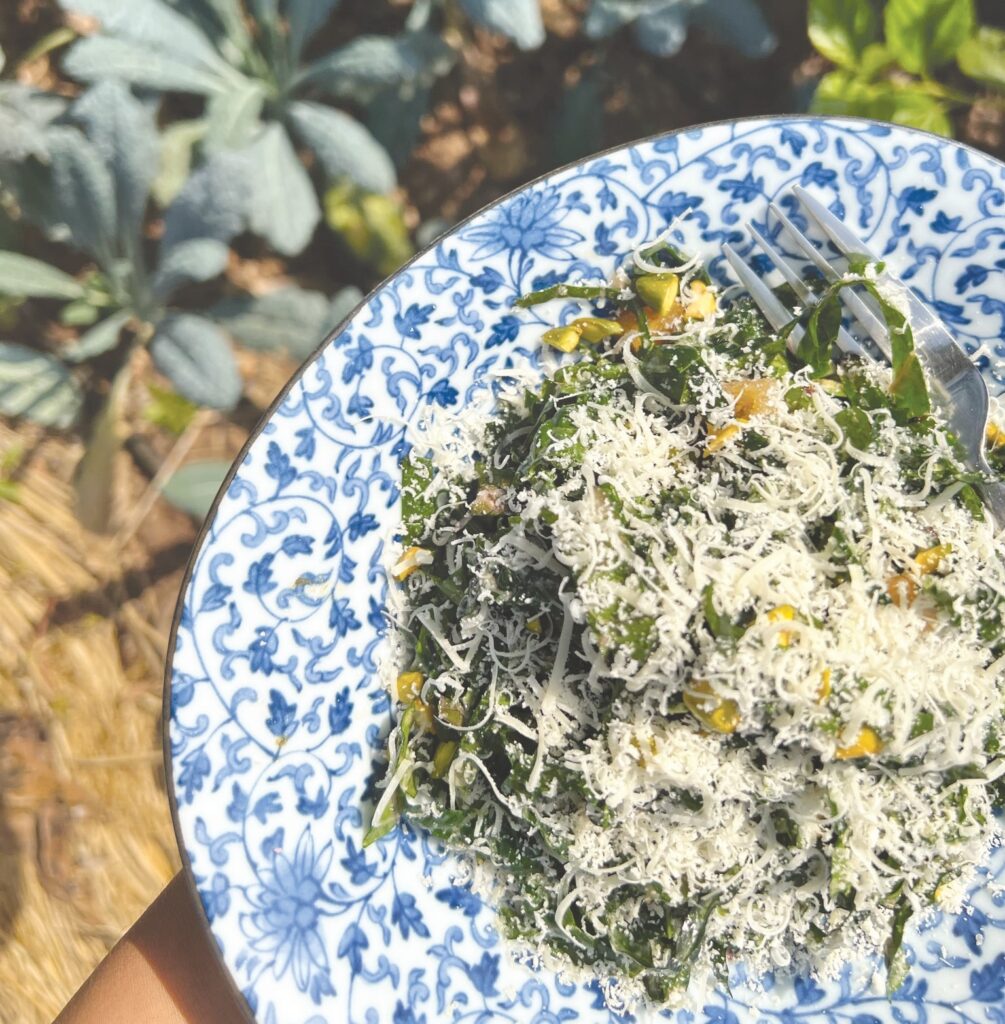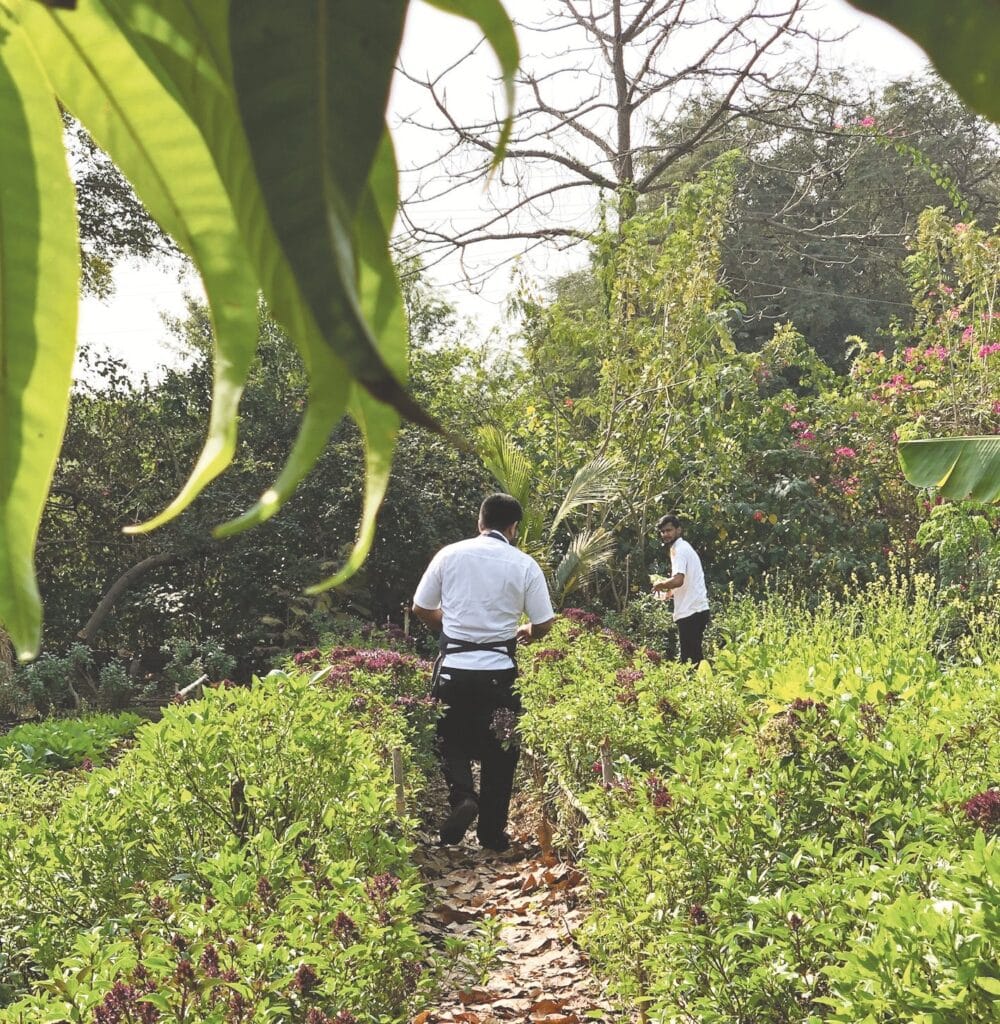“To understand why provenance is so important to chefs, one needs to unravel the food philosophy behind ingredient driven menus”
– GAURI DEVIDAYAL
In March 2014, Devidayal took a small group of people to The Table Farm in Alibaug where they harvested the produce that was then used to make their lunch. Since then, excursions to the farm in Alibaug have been consistently sold out.
What’s really on your plate? And where does it come from? Gauri Devidayal, the woman behind some of our favourite Mumbai restaurants and The Table Farm in Alibaug, sheds light on produce and provenance, organic farming and building a real farm-to-table ecosystem.
”I’m fresh off a flight from California, the OG of the farm-to-table movement, championed by Alice Waters, who opened Chez Panisse in the early 1970s and was notorious for serving just one perfect peach with a knife for dessert. Fifty years later, the movement not only continues there, but is thriving. ‘Organic’ is no longer counterculture, it’s as mainstream as it gets. Almost every restaurant I had dined at, between Los Angeles and San Francisco, paid homage to the farms from which it sources its ingredients. But doesn’t all produce come from some farm or the other? So what’s all the fuss about?
To understand why provenance is so important to chefs, one needs to unravel the food philosophy behind ingredient-driven menus. I had the privilege of dining at Nopa in San Francisco, which is a restaurant that simply describes itself as specializing in “simple food created with seasonal ingredients sourced from local purveyors”. To really get under the skin of this, I accompanied production chef Sean Eastwood to the renowned Ferry Plaza Farmers Market.

We spent a few hours that morning walking around several stalls with a large trolley that needed to be repeatedly loaded with crates overflowing with fresh produce, followed by multiple trips unloading it into Eastwood’s van. I asked him why he needed to come and personally buy produce from the market three times a week and why the farmers and vendors couldn’t just supply him at the restaurant directly, like we do in India. He explained, quite categorically, that if you want the good stuff you have to come and get it. There’s limited supply and demand is high.
The produce comes from small, local and regional farmers and ranchers, many of whom are certified organic. Being chemical-free means there’s scope for more spoilage of the crop due to pests and it also takes longer for produce to grow naturally when the process isn’t expedited using chemical fertilizers. All this results in it being considerably more expensive. But these very farmers are trustworthy sources of crops that are bursting with flavour and variety and which are sustainably farmed, ensuring that natural resources are not destroyed in the process. The microclimate of California has farms predominantly located within close proximity to the markets, which means the harvest has travelled a relatively short distance, thus reducing the environmental impact.

I saw a sincere relationship and exchange between the farmers and Eastwood, who seemed equally vested in each other’s success. Seasonally changing, locally-sourced, ingredient-driven menus are an outcome of this symbiotic relationship between farmers and chefs. Across the board, most restaurant menus I came across were short, yet hard to choose from because one knew everything was made from the best of the season, even if it meant a single peach.
India, on the other hand, hasn’t even begun to scratch the surface. About ten years ago, every second restaurant started labelling itself as a farm-to-table concept. Sure, all produce comes from some farm or the other, but did chefs truly know the farmers or where they’re located? Or what went into the soil and which seeds were used? And whether it was sustainable, organic, natural, chemical-free? Had the middleman been eliminated and were they sourcing directly? Highly unlikely and therefore not quite the movement here that is now second nature in California.

It was this very misinformation that led me to do the first walk-through at The Table Farm in Alibaug, just across the bay from Mumbai, where we grow a lot of the produce that our restaurant, The Table, uses. In March 2014, we took our first small batch of people to the farm and got them to do everything from mixing manure and cocopeat, to making plant beds and sowing seeds, even harvesting the produce for our chefs to make a farm-fresh lunch. It gave them a whole new perspective on the tomato salad that was served with freshly made pesto pasta and sautéed spinach, considering the tomatoes had been handpicked by the diners themselves. Having an awareness of not just where and how your produce is grown but also an appreciation for the labour involved in harvesting, cleaning and cooking can result in a seismic shift in the dining experience.

Restaurants and chefs have a significant responsibility in contributing to building this awareness, but the unfortunate reality is that most are not able to make the switch to a more sustainable source for their produce. Pricing is the key roadblock in a largely price-sensitive economy. That’s why this remains an urban phenomenon and you can probably count the number of restaurants that are doing this on both hands, including Masque, Edible Archives and Sequel, to name a few.
But all is not lost. Incidentally, India is one of the largest exporters of organic produce globally. Closer home, e-commerce brand Zama Organics is trying to bridge the distance between the source of chemical-free produce and the consumer, whether it’s direct to consumers through its website, or via restaurants and grocery chains. Its founder Shriya Naheta Wadhwa explains that Zama’s ethos is to promote clean eating by making quality, sustainably grown produce more accessible and taking care of the process of identifying and vetting passionate farmers and artisans, as well as the logistical aspect of making it available to the consumer. Interestingly, she also highlights that during the peak season for certain fruits and vegetables, the price on Zama’s website is the same if not less than what’s available at the local vegetable vendor. She recognizes the challenge of being faced with an audience that assumes organic equates with expensive, has bargaining in their blood, and wants instant gratification, but is confident that a slow but steady change is under way as the consumer becomes more health conscious.
This sentiment is echoed by Aindrila Mitra, editor-in-chief, Travel + Leisure India & South Asia, who introduced a category for Best Farm to Table experience at the magazine’s Delicious Dining Awards 2022. She explained that conscious travel is one of the pillars for the publication, and with that comes conscious living, conscious dining and conscious consumption. The current trend of sustainable living—whether it’s what you consume or where and how you travel—is a result of the Indian consumer generally being more mindful than before.

Similarly, a vision to bring the farm ecosystem closer to its end consumer and offer a deeper understanding of where our food comes from, who grows it and the impact of our food choices is what led chef Thomas Zacharias to trade in his post as chef partner of The Bombay Canteen for becoming a start-up founder of The Locavore. He acknowledges that we have a long road ahead in making consumers care—whether about themselves, the farmer or the environment—but that we can no longer turn a blind eye.
It’s the circle of life that we eventually find our way back to all the things that are good for us. Life began on farms before urbanization and processed foods took over our kitchens. And today, multiple stakeholders are going back to the grassroots to feed us in the most delicious, sustainable way. In the words of chef Laurence Jossel: a great restaurant is a sum of its parts.
And the provenance of its produce is an integral part. Here’s to those peaches, with no cream.”
“It’s the circle of life that we eventually find our way back to all the things that are good for us”
– GAURI DEVIDAYAL


